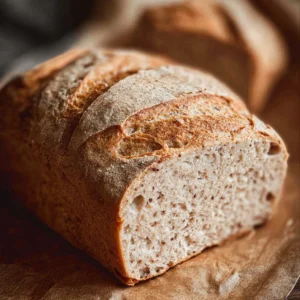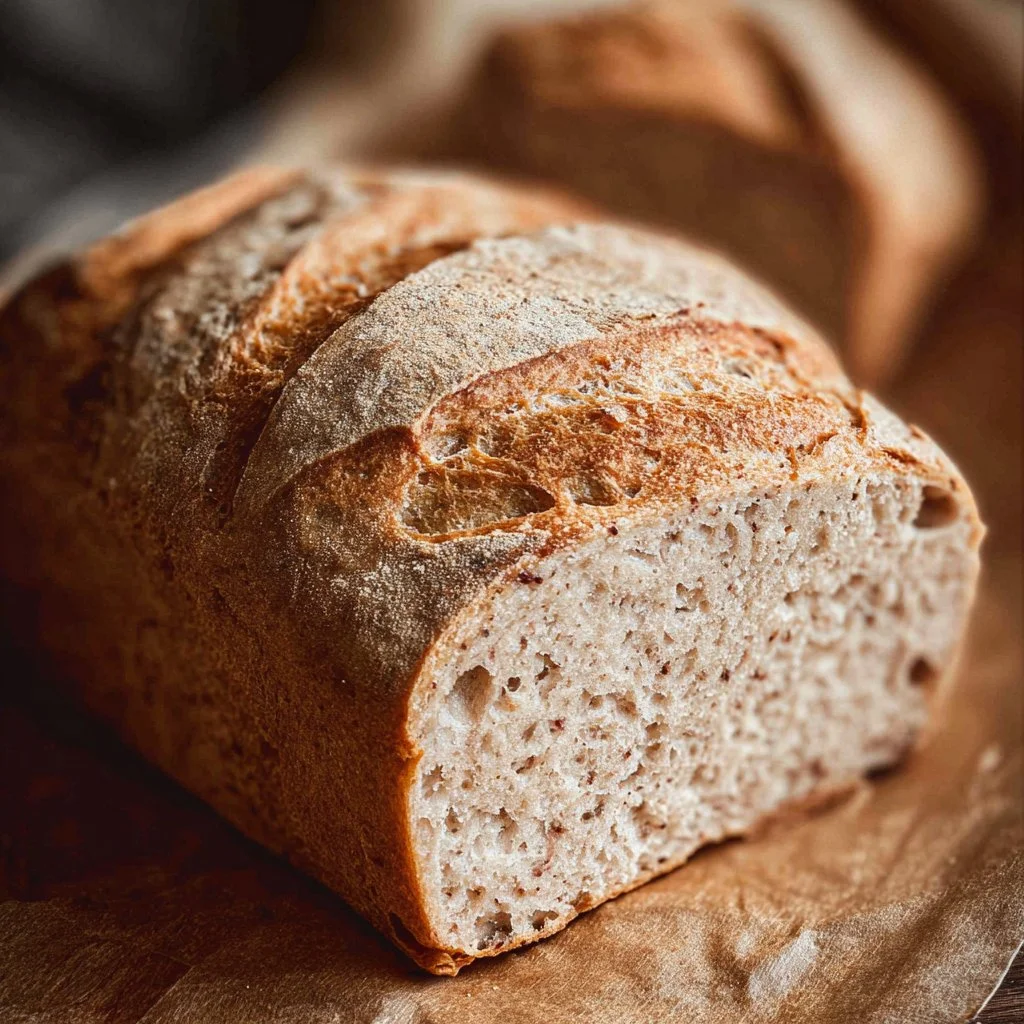Bread is a staple food that brings comfort and joy, but for those with gluten sensitivities or celiac disease, it can feel like a distant memory. If you miss enjoying bread fresh from the oven, then you are in for a treat! This Gluten Free Sourdough Bread recipe is not just another substitute; it’s a delightful creation that you can easily whip up in your own kitchen. With its crusty exterior and soft, chewy interior, this bread will have you questioning why you ever settled for store-bought gluten-free options.
Why We Love This Gluten Free Sourdough Bread Recipe
The allure of sourdough goes beyond its delightful taste; it carries a certain nostalgia that makes the experience of baking and enjoying it special. This Gluten Free Sourdough Bread not only caters to dietary restrictions but also satisfies the cravings for that artisanal sourdough flavor and texture. When you bite into a slice, you may find it hard to believe it’s gluten-free! The inclusion of wholesome ingredients—like brown rice flour and ground flax seeds—adds nutritional value while ensuring that every slice is fluffy and satisfying. Plus, the added layer of love that comes from preparing bread at home makes it all the more enjoyable. Whether you are whipping it up for breakfast, lunch, or dinner, this recipe will become a favorite in your collection.
Ingredients for Gluten Free Sourdough Bread
To create this scrumptious gluten-free bread, you’ll need a selection of ingredients that combine to produce a beautiful loaf. Here’s what you need:
- 1/2 cup (125 g) unfed gluten-free sourdough starter
- 1/2 cup (70 g) brown rice flour
- 1/4 cup (60 g) water
- 1 1/2 cups + 2 tablespoons (390 g) water
- 2 tablespoons (10 g) ground flax seed
- 1 cup (250 g) gluten-free sourdough starter
- 1 tablespoon (20 g) honey (or agave)
- 1/4 cup (60 g) olive oil
- 1 teaspoon (5 g) apple cider vinegar
- 1 1/2 cups (210 g) brown rice flour
- 1 cup (120 g) tapioca flour
- 1/2 cup (60 g) corn starch
- 2 tablespoons (16 g) psyllium husks
- 2 1/2 teaspoons (8 g) xanthan gum
- 2 teaspoons (10 g) salt
- 1 tablespoon baking powder
How to Make Gluten Free Sourdough Bread
Creating a loaf of gluten-free sourdough bread is a satisfying journey that requires a few simple steps. Here’s how you can embark on this culinary adventure:
Prepare Your Starter:
Begin by feeding your unfed gluten-free starter 12 hours ahead of time. In a clean jar, combine the unfed starter, brown rice flour, and 1/4 cup of water. Allow this mixture to rise until it is bubbly and active.Mix the Wet Ingredients:
In a separate mixing bowl, gather your wet ingredients: 1 1/2 cups + 2 tablespoons of water, ground flax seeds, your gluten-free sourdough starter, honey or agave, olive oil, and apple cider vinegar. Stir to combine and set this bowl aside.Combine the Dry Ingredients:
Next, in a stand mixer, measure out your dry ingredients. Add 1 1/2 cups of brown rice flour, 1 cup of tapioca flour, corn starch, psyllium husks, xanthan gum, salt, and baking powder. Mix these dry components for about 1-2 minutes until they are well incorporated and fluffy.Mix Wet and Dry:
With the stand mixer on the lowest speed, gradually pour the wet ingredients into the dry mixture. Beat the combined dough for approximately 5 minutes, ensuring everything is well mixed. If you find the consistency too thick, adjust by adding a little more water.Prepare the Baking Tin:
Line a 9″x5″ baking tin with parchment paper for easy removal. Pour the dough into the prepared tin, spreading it evenly across the surface. Now, it’s time to let your dough rise! Place it in a warm environment and allow it to rise for about 3-4 hours.Bake the Bread:
Once your dough has risen beautifully, preheat your oven to 375°F (190°C). Before placing it in the oven, score the top of the dough to allow steam to escape. Bake for 60 minutes, keeping an eye on it for that golden crust.Cool Before Slicing:
After baking, remove the bread from the pan immediately to avoid any sogginess. Allow it to cool completely on a rack before you start slicing. This step is crucial for achieving the perfect texture!
How to Serve Gluten Free Sourdough Bread
Serving this delicious gluten-free sourdough bread is where the fun really begins! You can enjoy it in a variety of ways that cater to both simple and elaborate tastes. Here are some delightful serving suggestions:
Toast it Up: One of the simplest and most beloved ways to enjoy your gluten-free sourdough is by toasting it. Top your slices with avocado, a sprinkle of salt, and red pepper flakes for a hearty breakfast. Don’t forget to experiment with different toppings, such as peanut butter, various jams, or even a hint of cream cheese.
Sandwiches for All: Use your freshly baked bread to create scrumptious sandwiches. Layer it with turkey and fresh spinach for a quick lunch, or make a classic grilled cheese. The bread holds up beautifully, giving you a satisfying bite in every mouthful.
Dipping Delight: Cut your gluten-free sourdough into strips for dipping purposes. Pair it with your favorite hummus or a homemade pesto for a delightful appetizer or snack.
Soups and Stews: Enjoy your sourdough alongside a comforting bowl of soup or stew. The bread will soak up the delicious broth, making for an exquisite culinary experience. Serve it warm for the best pairing!
Expert Tips: Gluten Free Sourdough Bread
Mastering the art of gluten-free sourdough bread takes practice, but there are several tips you can follow to ensure success:
Proper Fermentation: The fermentation process is crucial for both flavor and texture. Ensure that your sourdough starter is bubbly and active before incorporating it into your dough.
Warm Environment for Rising: To achieve the best rise for your dough, validate that the environment is warm. This will help activate the yeast and create the desired texture in your loaf.
Hydration is Key: Gluten-free flours can behave differently than regular flour, so don’t hesitate to adjust the water content as needed. Your dough may require a different level of hydration to reach the right consistency.
Temperature Awareness: Oven temperatures can vary, so keep an eye on your bread as it bakes. If the crust is browning too quickly, you can tent it with foil during the last part of baking.
How to Store Gluten Free Sourdough Bread
Storing your gluten-free sourdough bread properly is essential to maintain its freshness. Here are some straightforward tips:
Room Temperature: If you plan to consume your bread within a few days, it’s best to keep it wrapped in a clean kitchen towel and stored at room temperature.
Refrigerate for Longer Storage: For longer storage, consider placing your bread in an airtight container in the fridge. This will help extend its shelf life, but be aware that refrigeration can slightly alter the texture.
Freezing the Loaf: For optimal freshness, you can freeze your sourdough bread. Wrap it tightly in plastic wrap, place it in a freezer bag, and store it in the freezer. When you’re ready to enjoy it, simply pull out a slice and toast it directly from the freezer.
Variations of Gluten Free Sourdough Bread
Once you have mastered this gluten-free sourdough recipe, you might be curious about how to customize and create variations. Here are some fun ideas:
Herb-Infused Bread: Add dried herbs like rosemary or thyme to the dry ingredient mixture for a fragrant twist. This gives an aromatic flavor that works excellently with soups and salads.
Seeds and Nuts: Incorporate sunflower seeds, sesame seeds, or chopped walnuts to enhance both texture and nutritional content. You can mix these directly into the dough before pouring it into the bread tin.
Sweeten the Deal: For a slightly sweeter loaf, add cinnamon or chocolate chips. This will transform your sourdough into a delightful treat that’s perfect for breakfast or dessert.
Savory Add-Ins: Think about adding ingredients like sun-dried tomatoes, olives, or cheese to elevate the flavors. You’ll obtain a burst of taste with each bite!
FAQ
What is gluten-free sourdough bread?
Gluten-free sourdough bread is made using gluten-free flours and a sourdough starter that is free from gluten. It yields a delicious, crusty loaf that mimics traditional sourdough while accommodating those with gluten intolerances.
How does gluten-free sourdough bread taste compared to regular sourdough?
This gluten-free version provides a unique taste experience that rivals traditional sourdough. The fermentation process offers a tangy flavor, while the combination of gluten-free flours delivers a delightful texture.

Gluten Free Sourdough Bread
Ingredients
- ½ cup unfed gluten-free sourdough starter
- ½ cup brown rice flour
- ¼ cup water
- 1 ½ cups water
- 2 tablespoons ground flax seed
- 1 cup gluten-free sourdough starter
- 1 tablespoon honey (or agave)
- ¼ cup olive oil
- 1 teaspoon apple cider vinegar
- 1 ½ cups brown rice flour
- 1 cup tapioca flour
- ½ cup corn starch
- 2 tablespoons psyllium husks
- 2 ½ teaspoons xanthan gum
- 2 teaspoons salt
- 1 tablespoon baking powder
Instructions
- Feed your unfed gluten-free starter 12 hours ahead of time with brown rice flour and water until bubbly.
- In a mixing bowl, combine the wet ingredients: water, ground flax seeds, gluten-free sourdough starter, honey, olive oil, and apple cider vinegar.
- In a stand mixer, mix the dry ingredients: brown rice flour, tapioca flour, corn starch, psyllium husks, xanthan gum, salt, and baking powder.
- Gradually add the wet mixture to the dry ingredients and beat for about 5 minutes, adjusting water as needed.
- Line a 9×5 baking tin with parchment paper and pour the dough in, spreading it evenly.
- Let the dough rise in a warm environment for about 3-4 hours.
- Preheat the oven to 375°F (190°C). Score the top of the dough before baking.
- Bake for 60 minutes until golden brown.
- Remove from the pan and cool completely on a rack before slicing.
Send me this recipe!
Just enter your email below and get it sent straight to your inbox!


